Related Research Articles

A squall is a sudden, sharp increase in wind speed lasting minutes, as opposed to a wind gust, which lasts for only seconds. They are usually associated with active weather, such as rain showers, thunderstorms, or heavy snow. Squalls refer to the increase of the sustained winds over that time interval, as there may be higher gusts during a squall event. They usually occur in a region of strong sinking air or cooling in the mid-atmosphere. These force strong localized upward motions at the leading edge of the region of cooling, which then enhances local downward motions just in its wake.
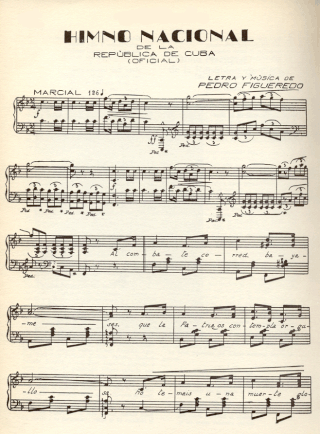
"El Himno de Bayamo" is the national anthem of Cuba. It was first performed in 1868, during the Battle of Bayamo. Perucho Figueredo, who took part in the battle, wrote and composed the song. The melody, also called "La Bayamesa", was composed by Figueredo in 1867.
Carlos Manuel de Céspedes del Castillo was a Cuban revolutionary hero and First President of Cuba in Arms in 1868. Cespedes, who was a plantation owner in Cuba, freed his slaves and made the declaration of Cuban independence in 1868 which started the Ten Years' War (1868–1878). This was the first of three wars of independence, the third of which, the Cuban War of Independence led to the end of Spanish rule in 1898 and Cuba's independence in 1902.

Bayamo is the capital city of the Granma Province of Cuba and one of the largest cities in the Oriente region.
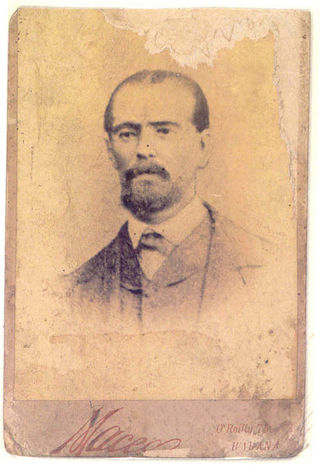
Pedro Felipe Figueredo,, mostly known as Perucho, was a Cuban poet, musician, and freedom fighter of the 19th century. In the 1860s, he was active in the planning of the Cuban uprising against the Spanish known as the Ten Years' War.

The Sierra Maestra is a mountain range that runs westward across the south of the old Oriente Province in southeast Cuba, rising abruptly from the coast. The range falls mainly within the Santiago de Cuba and in Granma Provinces. Some view it as a series of connecting ranges, which join with others to the west. At 1,974 m (6,476 ft), Pico Turquino is the range's – and the country's – highest point. The area is rich in minerals, especially copper, manganese, chromium, and iron.
Rafael "Felo" Ramírez was a Cuban-American Spanish language sports announcer, most notably for the Miami Marlins.

The Catholic Church in Cuba is part of the worldwide Catholic Church, under the spiritual leadership of the Pope in Rome. Catholics make up approximately half of the population of Cuba.

Francisco Vicente Aguilera was a Cuban patriot born in Bayamo, Cuba on June 23, 1821. He had ten children with his wife Ana Manuela Maria Dolores Sebastiana Kindelan y Sanchez. He studied at the University of Havana receiving the degree of Bachelor of Laws.
The University of Granma is a public university located in Bayamo, Cuba.
Carlos Manuel de Céspedes Airport is a regional airport serving the city of Bayamo in the Granma Province of Cuba. It is named for Carlos Manuel de Céspedes.

Buey Arriba is a municipality and town in the Granma Province of Cuba. It is located 30 kilometres (19 mi) south of Bayamo, the provincial capital.
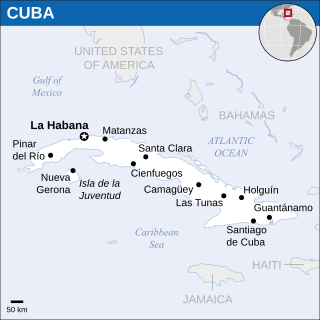
The Aponte conspiracy was a large-scale slave rebellion in Cuba that occurred in 1812. It is named after its alleged leader, José Antonio Aponte.
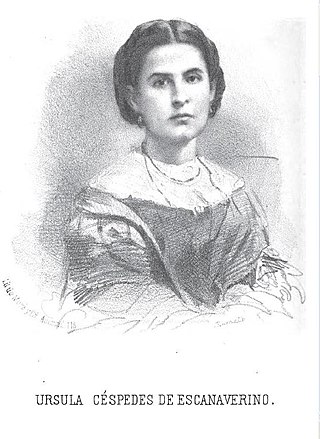
Úrsula Céspedes was a Cuban poet and founder of the Academia Santa Úrsula in Manzanillo, Cuba, originally from Bayamo, Cuba.

The Circuito Sur de Oriente (CSO), meaning "Southern Circuit of the Orient", is a west-east highway connecting Bayamo to Santiago de Cuba, through Manzanillo, Niquero and the southern coastal side of eastern Cuba, below the Sierra Maestra mountain range. Also known as Circuito Guacanayabo-Sur de Oriente, because it crosses the Gulf of Guacanayabo, the name Oriente, refers to the ancient and former Oriente Province. With a length of 347 km, it is the fourth-longest Cuban highway after the "Carretera Central", the "Circuito Norte" and the "Circuito Sur".
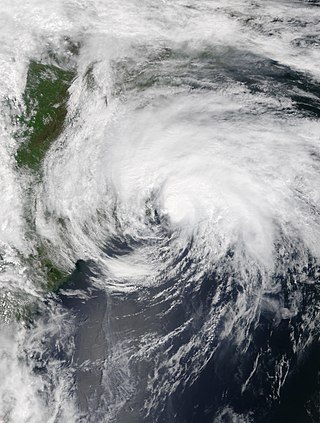
Tropical Storm Arthur was a strong off-season tropical cyclone that impacted the East Coast of the United States in May 2020. The first of thirty-one depressions and thirty different named storms of the extremely active 2020 Atlantic hurricane season, Arthur marked the record sixth consecutive year in the Atlantic basin with a tropical cyclone forming before June. It was one of two off-season storms in the season, alongside short-lived Tropical Storm Bertha. Arthur originated from a front that stalled over the Straits of Florida on May 10, which slowly drifted south for two days. The system became a tropical depression on May 16 north of The Bahamas. A day later, the system intensified into a tropical storm and was named Arthur. Arthur gradually intensified while tracking towards the Outer Banks of North Carolina, attaining its peak intensity with maximum 1-minute sustained winds of 60 mph (97 km/h) and a minimum central pressure of 990 mbar (29 inHg) on May 19, before skirting the region and becoming an extratropical cyclone. The cyclone then accelerated towards Bermuda and dissipated on May 21.

The Battle of Guisa was a relevant event in the history of Cuba. One of the major victories of the Rebel Army in the Liberation War (1956-1958) sustained against the dictatorship of Fulgencio Batista in Cuba.

The Battle of Peralejo was a military confrontation between Cuban independence rebels, under the command of Major General Antonio Maceo against the forces of the Spanish Army, under the command of Captain General Arsenio Martínez Campos, which was part of Maceo's First Eastern Campaign during the Cuban War of Independence.